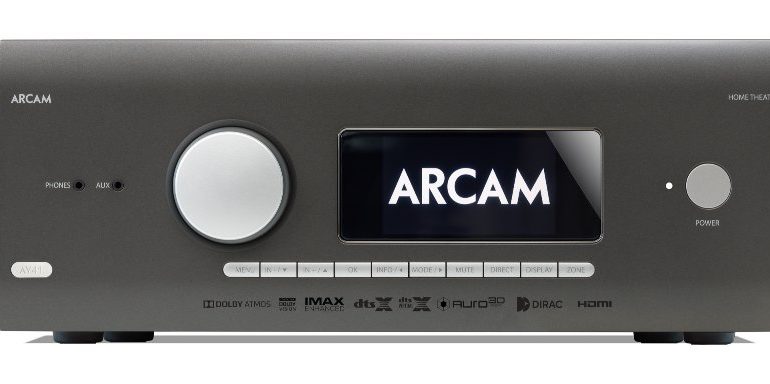Arcam Announces Their 2022 AV Receiver Lineup
After a long wait, Arcam has announced their 2022 AV receiver lineup. A trio of AV receivers and a single Pre-Pro that sport seven HDMI 2.1/HDCP 2.3 inputs supporting 4K/120 and 8K/60. They all come with Dirac Live room correction and a measurement microphone. Starting at $3050 for the AVR11 and topping out at $6900 for the AVR31, they are not cheap. So is Arcam’s new lineup in your future? Let’s discuss.
The Looks Of The 2022 Arcam Lineup
So I don’t know about you, but if I am dropping $3-7K on a new AV receiver or Pre-Pro, I want them to look good. Arcam doesn’t disappoint. The AVR11/21/31 and AV 41 all share nearly identical looks up front. All feature a large volume dial and a beautiful full-color display. A small, subdued plate tells us the model and basic silk screening with the company name. I’m not a massive fan of the various brands’ logos on the AV receiver. But I have wall plaques doing the same thing in my space. So, people in glass houses…
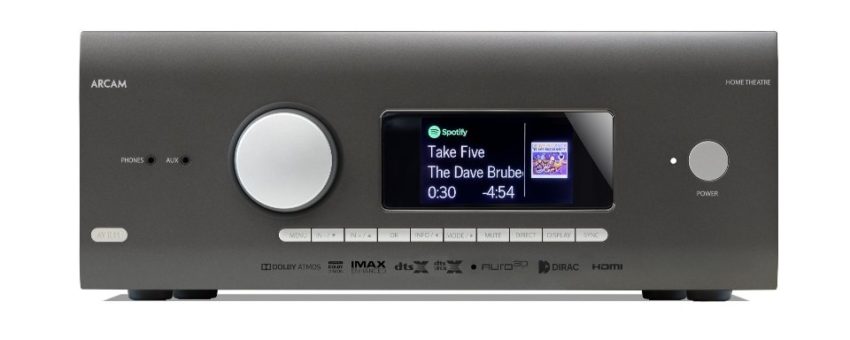
Back to that front display. Arcam has provided a large front screen. Not only is it color, but it’s large enough to allow you to scroll through your menus quickly. This feature may not seem like a huge deal. But this is amazing for anyone who has tried navigating an AV receiver menu, one line at a time!
Shared Features
As mentioned above, the entire Arcam lineup features HDCP 2.3 and HDMI 2.1 across all seven inputs. Plus, all support 4K/120 and 8K/60. I scoured the manual (and the brain of Rob H from AV Rant), but I couldn’t find out if all the inputs were the full 48gbps or capped at 40gbps like most newer HDMI 2.1 AV receivers. Either way, it is great to see the 2022 lineups emerging with all inputs HDMI 2.1 compliant. The entire Arcam lineup feature Dolby Vision and HDR10+ passthrough and have a single eARC output (you only need one). I am surprised that there doesn’t appear to be any upscaling or processing. For me, that’s a non-issue. Most of my devices, like the Nvidia Shield, support upscaling. So I don’t need it built into my receiver or pre-pro.
On the audio side, the entire Arcam lineup features Dolby Atmos, DTS:X, IMAX Enhanced, and (for the three people that care) Auro3D. That’s not exactly earth-shattering news as Atmos, DTS:X, and IMAX Enhanced are widely available now. Absent is DTS:X Pro, which is surprising for such a pricey lineup. And if Arcam adds something niche like Auro3D, why not add something equally as niche like front wide speakers?
Streaming and Room Correction
As is expected with a premium AV receiver, the Arcam lineup features integrated streaming. For example, they include Apple Airplay2, Google Chromecast, Bluetooth with aptX HD, Spotify Connect, Tidal Connect, and UPnP with the MusicLife app. While not as robust as my Onkyo TR-NX7100, there is a lot for streaming music lovers. For those with physical media like CDs, a pair of onboard ESS Sabre DACs handle all of your conversion. That doesn’t mean much to the average person, but the ESS Sabre DACs are highly regarded in the audiophile community.
Lastly, room correction is provided through Dirac Live. If you have been living under a rock, Dirac Live is now “THE” room correction everyone wants. My Onkyo features Dirac Live, and to be honest; I haven’t noticed a lot of differences from Audyssey. (Put down your torches and pitchforks!) All models come with a measurement mic, and I noticed a calibration file on the Arcam website. The mic is USB and must be used with a computer, so that might be a hurdle for some. The manual is very sparse on detail, but I am pretty sure the mic is generic, not individually calibrated, like the UMIK-1 from Cross-Spectrum Labs (which you could use instead if you had one). You can also get Dirac Live bass management, but that’s an extra license (and cost). And if you have dual subs, you need to move up to the AVR21 to get dual sub support.
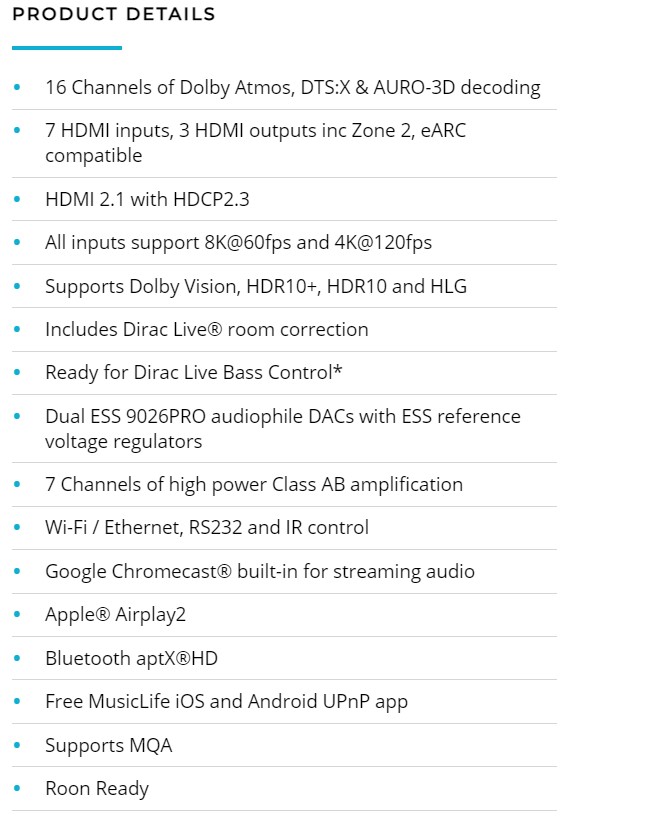
Around Back
Just like the front, the back of the Arcam lineup shares a similar look.
First, all AV receivers (AVR11/21/31) feature a full set of RCA pre-outs. The pre-outs will allow you to you add external amplification or enable you to process additional channels. The Arcam AV41 Pre-Pro has both the RCA pre-outs and a full set of balanced XLR outputs.
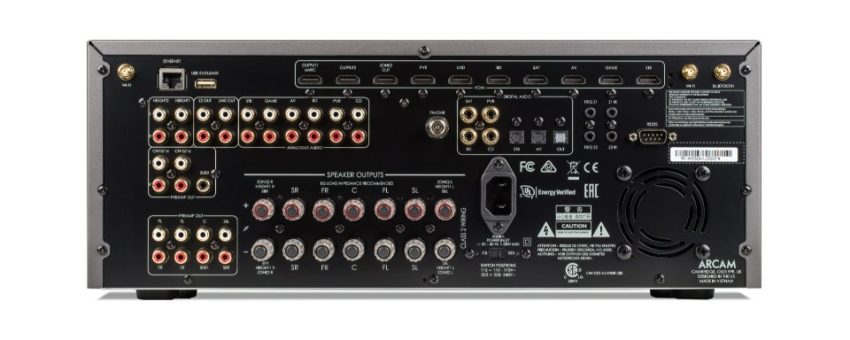
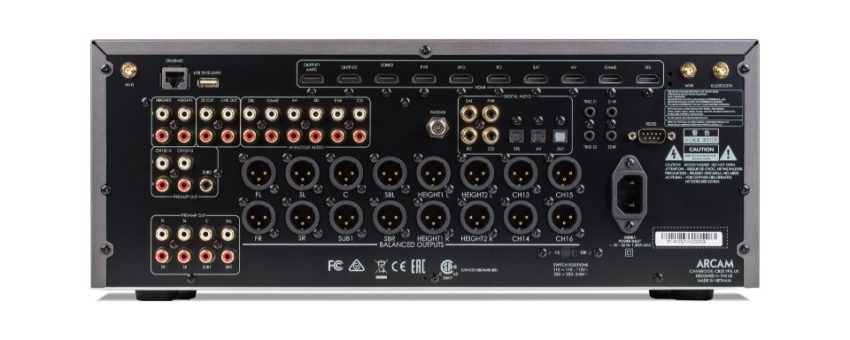
Five-way binding posts make sure your speaker wire connections are solid and that you have lots of connection options. For those who have some analog gear, there are plenty of inputs. Plus, they have lots of digital connections. Options galore! Missing is a phono preamp. But hey, if you are paying this much for an AV receiver, you probably have a phono preamp already.
If you want Zone 2 functionality, you will need to skip the AVR11 and go with the AVR21/31 or AV41. This doesn’t sit particularly well with me. A $3000 “entry-level” AV receiver should have Zone 2 capabilities.
Specs for the Arcam 2022 AV Receiver Lineup
While the outsides of the new 2022 Arcam Lineup may share some very similar features, under the hood, there are some significant differences in amplification and signal processing. Let’s discuss it!
Arcam AVR11
The Arcam AVR11 ($3050) includes seven channels of amplification, rated at 80 WPC (watts per channel) (2 channels driven). Although it has amps for seven, it can process up to 11 speakers for a full 7.2.4 configuration.
As I said above, it has a full set of RCA pre-outs for external amplification of your existing speakers or to power the additional four channels. Unfortunately, there is no Zone 2 output.
Arcam AVR21
The Arcam AVR21 ($4700) also has seven channels of class A/B amplification but bumps the power to 110 WPC. It features processing for up to 15 channels, allowing you to have a full 9.2.6 system.
You do get a Zone 2 output, allowing you to extend your system into another space if required.
Arcam AVR31
The Arcam AVR31 ($6900) doesn’t offer any additional features over the AVR21. Instead, you get seven Class G hybrid amps that run the first 20 watts in pure Class A. Then, you can switch seamlessly over to class A/B to push it up to 120 WPC.
I am not as familiar with Class G amps, but what I have read describes them as a hybrid car. You have two power sources that work at different paces. When you don’t need a lot of power, the Class A amps do all the work. But when you start to get dynamic or more demanding media, the Class A/B kicks in to take over and get you up to that 120 WPC. So the Class G amps mean you will have exceptional power handling and output no matter what you listen to.
Arcam AV41
The Arcam AV41 ($5250) is basically a Pre-Pro version of the AVR21. It offers 15 channels of processing and will have full XLR outputs. Basically you are trading in the amps for the XLR outputs and paying more for the “luxury.”
Code Embed: Cannot use CODE1 as a global code as it is being used to store 158 unique pieces of code in 839 posts
Our Take on the Arcam 2022 AV Receiver Lineup
So this is a hard one for me. The Arcam 2022 AV receiver lineup has many bells and whistles that we look for. So you are paying a premium for them and the Arcam name. While I don’t doubt they will be performers, do they justify the premium pricing?
As well, Arcam is very light on details. I am accustomed to getting a full spect sheet that lays out everything I need to know. I recruited Rob H from AV Rant, and he didn’t find any sources that could give us the details we wanted.
My take? Great AV receivers, premium pricetags. The standout here is the AVR21. Few AV receivers on the market can process 9.2.6, and the AVR21 will be one of the least expensive. If I were in the market for Arcam, that is the one I would want. Though, I’m a little hesitant as I would be tempted to wait until we see if they offer DTS:X Pro and what their implementation of Dirac is like. So before I hit the buy button, I would likely pause and wait.
For more information, visit Arcam.co.uk.

